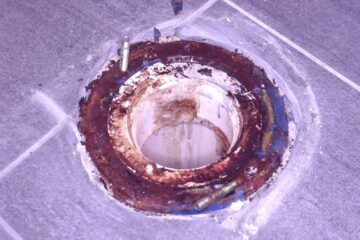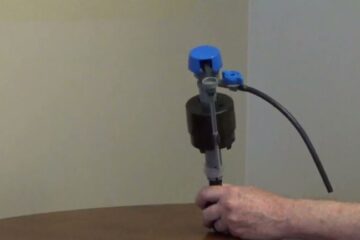How to Replace a Bathroom Sink
If you’ve been contemplating updating your bathroom or simply need to replace a worn-out sink, this article is here to guide you through the process. Whether you’re an experienced DIY-er or just starting to tackle home improvement projects, learning how to replace a bathroom sink is a useful skill that can save you time and money. In this article, we’ll walk you through the step-by-step process of replacing and installing a bathroom sink, providing you with helpful tips along the way.
By the end, you’ll feel confident in tackling this project on your own and transforming your bathroom into a more stylish and functional space.
How to Replace and Install a Bathroom Sink
Are you looking to update your bathroom and give it a fresh new look? One of the easiest and most impactful changes you can make is to replace your old bathroom sink. Whether your sink is cracked, outdated, or simply no longer suits your style, replacing it can make a world of difference.
In this article, we will guide you through the process of replacing and installing a bathroom sink, from gathering the necessary tools to testing the functionality of your new sink. You don’t need to be a professional plumber to tackle this project – with a little bit of preparation and some handy tools, you’ll have a beautiful new sink in no time!
Preparation
Before you begin the process of replacing your bathroom sink, it’s important to gather all the necessary tools and materials. This will ensure that you have everything you need within reach, saving you time and frustration. Here’s a list of tools and materials you’ll need:
Gather the necessary tools and materials
- Adjustable wrench
- Screwdriver
- Putty knife
- Bucket
- Pliers
- Plumber’s tape
- Silicone adhesive
- Caulk gun
- Measuring tape
Once you have all the tools and materials ready, the next step is to turn off the water supply. This is crucial to prevent any leaks or water damage during the installation process.
Turn off the water supply
Locate the shut-off valves under the sink and turn them clockwise until the water flow is completely shut off. If you can’t find the shut-off valves, you may need to turn off the main water supply to your house. It’s always a good idea to test the water flow to ensure it has been properly shut off before proceeding.
Prepare the work area
Before you start removing the old sink, it’s important to prepare the work area. Clear out any items from the area around the sink and create a clean workspace. Lay down a protective drop cloth or old towels to catch any water or debris that may fall during the process.
Removing the Old Sink
Now that you have your work area prepared, it’s time to remove the old sink. Follow these steps to ensure a smooth removal process:
Disconnect the water supply lines
Using an adjustable wrench, loosen the nuts that connect the water supply lines to the shut-off valves. Once the nuts are loose, you can remove the supply lines from the valves. Be sure to have a bucket or towel handy to catch any water that may still be in the lines.
Remove the sink drain
To remove the sink drain, place a bucket underneath the sink to catch any water that may be trapped in the drainpipe. Use pliers to loosen the slip nut that connects the P-trap to the drainpipe. Slowly remove the P-trap and set it aside. Next, use a screwdriver to remove the screws or nuts that attach the drain assembly to the sink. Once the screws or nuts are removed, you can lift the old sink drain out of the sink.
Disconnect the sink from the countertop
Examine how the old sink is attached to the countertop. In most cases, there will be clips or brackets underneath the sink that hold it in place. Use a screwdriver or wrench to loosen and remove these clips or brackets. Once they are removed, you should be able to lift the old sink out of the countertop. Be careful not to damage the countertop or any surrounding tiles during this step.
Remove any caulking or adhesive
After the sink is removed, there may be residual caulking or adhesive on the countertop. Use a putty knife to carefully scrape away any remaining caulking or adhesive. Take your time with this step to ensure a smooth and clean surface for the installation of your new sink.
Choosing a New Sink
Now that you have successfully removed the old sink, it’s time to choose a new one that fits your preferences and the style of your bathroom. Consider the following factors when selecting a new sink:
Measure the existing sink
Before you start shopping for a new sink, it’s important to measure the dimensions of your existing sink. This will ensure that your new sink will fit properly in the same space. Measure the width, length, and depth of the sink, as well as the distance between the faucet holes.
Consider sink style and type
There are various styles and types of bathroom sinks to choose from, including drop-in sinks, under-mount sinks, vessel sinks, and wall-mounted sinks. Consider the existing style of your bathroom and choose a sink that complements the overall aesthetic.
Select the material for the sink
Bathroom sinks are available in a wide range of materials, including porcelain, stainless steel, glass, and stone. Each material has its own unique characteristics and maintenance requirements. Consider the durability, maintenance, and appearance of different materials before making your final decision.
Determine the installation method
Depending on the type of sink you choose, the installation method may vary. Some sinks require countertop cutouts, while others are designed to sit on top of the countertop. Take into account your DIY skills and comfort level when choosing an installation method.
Preparing for Installation
Once you have chosen your new sink, it’s important to ensure that it is compatible with your existing setup and make any necessary preparations before installation.
Check the new sink for compatibility
Before proceeding with the installation, carefully examine the new sink to ensure that it will fit properly in the existing space. Check the dimensions, faucet hole placement, and mounting options to ensure a proper fit.
Make any necessary modifications to the countertop
If your new sink requires a countertop cutout or any modifications to the existing countertop, now is the time to make those adjustments. Follow the manufacturer’s instructions and use the appropriate tools to make any necessary modifications. Take your time to ensure accuracy and avoid damaging the countertop.
Prepare the drain assembly
Before installing the new sink, prepare the drain assembly by attaching the necessary components. Follow the manufacturer’s instructions for assembling the drain, ensuring a secure and watertight connection. Apply the plumber’s tape to the threaded connections to prevent any leaks.
Apply sealant or adhesive
To ensure a secure and watertight seal, apply a bead of silicone adhesive or caulk around the perimeter of the sink cutout. This will prevent any water from seeping between the sink and the countertop. Use a caulk gun to apply an even and consistent bead of sealant. Smooth the sealant with your finger or a caulk smoothing tool for a professional finish.
Installing the New Sink
With all the necessary preparations complete, it’s time to install the new sink. Follow these steps for a successful installation:
Position the sink onto the countertop
Carefully lift the new sink and position it onto the countertop cutout or mounting brackets. Ensure that the sink is centered and aligned properly. Take your time with this step to avoid any damage to the sink or countertop.
Connect the sink to the countertop
If your sink requires mounting brackets, use a screwdriver or a wrench to tighten the brackets and secure the sink in place. Follow the manufacturer’s instructions for the specific mounting method.
Install the drain assembly
Lower the new sink drain into the drain hole on the sink. Secure the drain assembly using the screws or nuts provided by the manufacturer. Ensure that the drain assembly is tightly attached to the sink to prevent any leaks.
Connect the water supply lines
Reconnect the water supply lines to the shut-off valves. Use an adjustable wrench to tighten the nuts and ensure a secure connection. Wrap the plumber’s tape around the threaded connections to prevent any leaks.
Securing the Sink
After successfully installing the new sink, it’s important to secure it properly to ensure stability and prevent any future problems.
Tighten mounting brackets or clips
If your sink is mounted using brackets or clips, ensure that they are tightened securely. This will prevent the sink from shifting or becoming loose over time.
Ensure the sink is level
Use a level to check if the sink is level. Adjust the mounting brackets or clips as necessary to achieve a level position. This will help prevent water from pooling on one side of the sink.
Apply caulking or adhesive
Apply a bead of silicone adhesive or caulk around the perimeter of the sink where it meets the countertop. This will provide an additional layer of protection against water leaks and also keep the sink securely in place. Smooth the caulk with your finger or a caulk smoothing tool for a clean and professional finish.
Clean up any excess sealant
After applying the caulk, clean up any excess sealant with a damp cloth or sponge. This will ensure a neat and tidy appearance. Allow the sealant to cure according to the manufacturer’s instructions before using the sink.
Testing the Sink
Now that your new sink is securely installed, it’s time to test its functionality and ensure that everything is in working order.
Turn on the water supply
Turn on the water supply by gradually opening the shut-off valves. Check for any leaks around the water supply lines and the drain assembly. If you notice any leaks, turn off the water supply and tighten the connections as necessary.
Check for any leaks
After turning on the water supply, closely inspect the sink and its connections for any signs of leaks. Check both the hot and cold water lines, as well as the drain assembly. If you notice any leaks, tighten the connections or seek professional assistance if needed.
Test the sink’s functionality
Fill the sink with water and test the faucet handles and drain stopper mechanism. Ensure that the water flows smoothly and drains properly. Test the hot and cold water settings to ensure that they are functioning correctly.
Make adjustments if necessary
If you encounter any issues during the testing phase, such as slow drainage or a faulty faucet, make the necessary adjustments or repairs. Consult the manufacturer’s instructions or seek professional assistance if needed. It’s important to address any issues before finalizing the installation.
Finalizing the Installation
With the sink successfully installed and tested, it’s time to finalize the installation and put the finishing touches on your bathroom upgrade.
Reconnect any additional components
If you had to disconnect any additional components, such as a garbage disposal or a soap dispenser, now is the time to reconnect them. Follow the manufacturer’s instructions for each component and ensure a secure and proper connection.
Clean the sink and surrounding area
Using a mild cleaner or soap and water, clean the new sink and the surrounding area. Remove any dirt, dust, or adhesive residue to reveal the full beauty of your new sink. Use a soft cloth or sponge to avoid scratching the sink’s surface.
Dispose of the old sink properly
Dispose of the old sink responsibly by following your local regulations. If the sink is in good condition, you may consider donating it to a local charity or organization. If it’s damaged or no longer usable, contact your local waste management services to arrange for proper disposal.
Enjoy your new bathroom sink!
Congratulations, you have successfully replaced and installed your new bathroom sink! Take a moment to enjoy the fresh look and enhanced functionality of your updated bathroom. You deserve it!
FAQs
How long does it take to replace a bathroom sink?
The time it takes to replace a bathroom sink can vary depending on factors such as the complexity of the installation, your level of experience, and any unforeseen issues that may arise. On average, it can take a few hours to complete the entire process.
Can I replace a bathroom sink without professional help?
Yes, replacing a bathroom sink is a DIY-friendly project that can be done without professional help. However, it’s important to have some basic plumbing knowledge and skills. If you are not confident in your abilities, it’s always a good idea to consult a professional plumber.
What tools do I need for replacing a bathroom sink?
Some of the tools you will need for replacing a bathroom sink include an adjustable wrench, screwdriver, pliers, putty knife, bucket, and caulk gun. The specific tools required may vary depending on the installation method and the type of sink you choose.
Do I need to shut off the water supply to replace the sink?
Yes, it is essential to turn off the water supply before replacing a bathroom sink. This will prevent any water leakage or damage during the installation process. Locate the shut-off valves under the sink and turn them clockwise to shut off the water flow.
How do I choose the right size of a bathroom sink?
To choose the right size of a bathroom sink, measure the dimensions of your existing sink. Measure the width, length, and depth of the sink, as well as the distance between the faucet holes. Use these measurements as a guide when selecting a new sink.
What is the average cost of replacing a bathroom sink?
The cost of replacing a bathroom sink can vary depending on factors such as the type of sink, materials used, and any additional plumbing work required. On average, the cost can range from $200 to $1000 or more, including the sink, installation materials, and any professional assistance if needed.
Are there any safety precautions to keep in mind while replacing a sink?
While replacing a bathroom sink is generally a safe DIY project, it’s important to take some safety precautions. Always wear protective gloves and safety goggles when working with tools and sharp objects. Exercise caution when handling plumbing connections and avoid over-tightening or damaging them.
Can I reuse the old sink’s drain assembly?
In some cases, you may be able to reuse the old sink’s drain assembly if it is still in good condition and compatible with your new sink. However, it is recommended to replace the drain assembly with a new one to ensure proper functionality and prevent any future issues.
How often should I replace my bathroom sink?
The lifespan of a bathroom sink can vary depending on factors such as the quality of materials and usage. On average, a bathroom sink can last for 15-20 years or more with proper care and maintenance. However, if your sink is damaged, outdated, or no longer suits your style, it may be a good time to replace it.
Are there any specific maintenance steps for a new bathroom sink?
To keep your new bathroom sink in optimal condition, it’s important to follow some maintenance steps. Clean the sink regularly using mild cleaners or soap and water. Avoid using abrasive materials that could scratch the surface. Wipe away any water or spills promptly to prevent staining or water damage.



